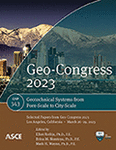Correlation of Expansion Index and Atterberg Limits for Expansive Soils
Publication: Geo-Congress 2023
ABSTRACT
Expansive soils cause damage to many types of construction throughout the world, however, their presence is not always well recognized. Expansive soils are generally clayey soils that undergo swelling and shrinkage in cycles with changes in moisture contents. Many classification techniques exist to identify expansive soils, with use of the Atterberg Limits and Hydrometer testing being the most prevalent. A direct measurement test, the Expansion Index (ASTM D4829), exists to classify expansive soils in a consistent manner. Due to its relative quick testing time and low cost, the EI is often used in practice as a screening tool to identify the presence of expansive soils, as required by the building code, for sites with variations in soil composition, without a direct incorporation in design formulae. Conversely, the Atterberg Limits and Hydrometer Tests, despite their costs and longer time for testing, are often required to be determined to accomplish the foundation design per the Wire Reinforcement Institute (WRI) method, or the Post Tensioning Institute (PTI) method, as required by code. In practice, not all samples collected for EI testing are used for Atterberg Limits and Hydrometer Tests. Therefore, a correlation between the two index tests may be useful. A direct correlation between the Expansion Index (EI) and the Atterberg Limits (LL and PI) has not been previously established. Laboratory test data on samples where both EI and Atterberg Limits (LL and PI) have been conducted for the same sample have been collected. Correlations between the two have been determined and are reported within. Additionally, some samples where hydrometer tests were also conducted have been used to further understand the correlations between the two primary index test types. Results indicate there is a general linear trend between the EI and the LL and PI values; however, there is a wide scatter in the ranges of the data indicating the correlation is variable and only loosely correlated. Reasons for the results are discussed.
Get full access to this article
View all available purchase options and get full access to this chapter.
REFERENCES
ASTM. (1962). Standard Test Method for Particle Size Analysis, Designation D422.
ASTM. (2021). Standard Test Method for Expansion Index of Soils, Designation D4829-21.
ASTM. (2017). Standard Test Method for Liquid Limit, Plastic Limit, and Plasticity Index of Soils, Designation D4318-17.
ICC (International Code Council). (2021). 2018 International Building Code (IBC), Chapter 18 Soils and Foundations.
Nelson, J. D., Chao, K. C., Overton, D. D., and Nelson, E. J. (2015). Foundation Engineering for Expansive Soils, Published by John Wiley and Sons.
PTI (Post Tensioning Institute). (2019). Standard Requirements for Design and Analysis of Shallow Post Tensioned Concrete Foundations on Expansive and Stable Soils, PTI DC-10.5-19.
Skempton, A. W. (1953). The Colloidal Activity of Clays, Proceedings of the 3rd International Conference on Soil Mechanics and Foundation Engineering, p57–61.
WRI (Wire Reinforcement Institute). (1996). Design of Slab-on-Ground Foundations – with 1996 Update.
Zapata, C., Houston, S., Houston, W., and Dye, H. (2006). Expansion Index and Its Relationship with Other Index Properties. 2133–2137. https://doi.org/10.1061/40802(189)180.
Information & Authors
Information
Published In
History
Published online: Mar 23, 2023
Authors
Metrics & Citations
Metrics
Citations
Download citation
If you have the appropriate software installed, you can download article citation data to the citation manager of your choice. Simply select your manager software from the list below and click Download.
